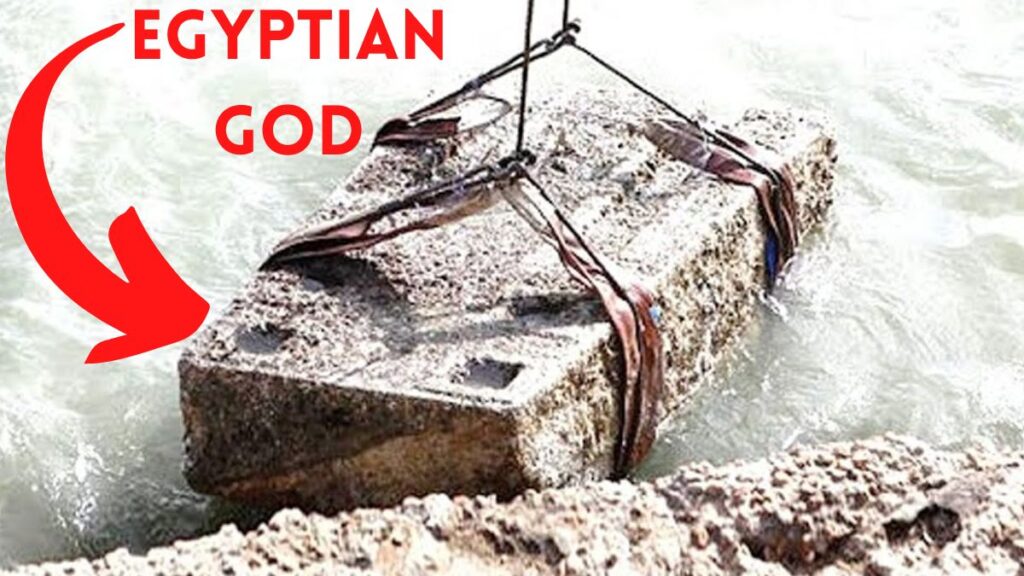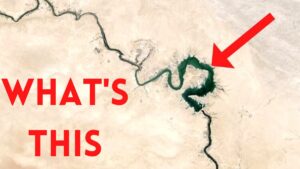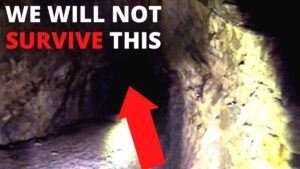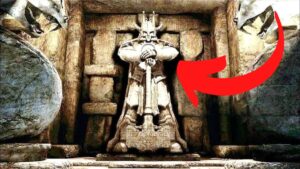
Egypt continues to yield a number of inexplicable discoveries to this day. This is due to the fact that the ancient Egyptians were a civilization that created impressive structures and inventions and was so far ahead of their time and age. They were also recognized as a civilization for their interactions with astronomy and scientific accomplishments.
Egypt’s discoveries require scientists to conduct extensive research in order to provide answers. However, their most recent discovery is not only astonishing the scientific community as a whole but also leaving them clueless. What were they found? Are there any secrets that the ancient Egyptians kept from the rest of the world? Join us as we investigate the frightening new discoveries in Egypt. Following excavations in prominent parts of Egypt, scientists have recently announced that they have discovered the tomb of the Egyptian god Osiris next to the River Nile. Then, archaeologists and scientists looked into the Theban Necropolis. The ancient Egyptian city of Thebes, which is now known as modern-day Luxor, was directly in front of the enormous Theban Necropolis, which consisted of ancient temples and tombs.
Archaeologists discovered an ancient tomb on the West Bank of the Nile that was constructed in the style of the mythical tomb of Osiris within these combinations of ancient tombs and temples.
It was discovered in Sheikh Abdul Karnah, one of Egypt’s oldest cities and home to the largest concentration of private tombs in the Theban Necropolis complex. During the New Kingdom, it was the burial ground for all prominent people, priests, and officials of the highest rank. The 18th, 19th, and 20th dynasties of Egypt ruled Egypt during the New Kingdom, which lasted from the 16th century BC to the 11th century BC. Philippe Virey first discovered a portion of the tomb in 1887, but it was never described or published. A group of Spanish and Italian archaeologists led by Maria Alvarez Sosa of the MIN project worked together to excavate its various chambers and shafts as modern archaeologists looked around in search of more discoveries.
They said that the large tomb of Osiris, a god who was a big part of ancient Egyptian mythology, had been modeled after it after gathering information from the carvings and compositions inside the tomb.
Archaeologists think the tomb was built between 760 and 656 BC or 672 and 525 BC, which are the 25th and 26th dynasties, respectively, based on what they’ve found and learned about it. A comparison to similar tombs that contain Osirian elements serves as the basis for the postulation of these periods. In point of fact, the Osirian, or Iris’s tomb, is an obvious and well-known illustration. It is incorporated into the funeral complex of Seti I. Osiris is regarded as the god of the dead, the afterlife, and the underworld in Egyptian mythology.
His characteristic features include a Pharaoh’s beard and bright emerald green skin. He is depicted with his legs wrapped up like a mummy and a crown made of two magnificent ostrich feathers.
Additionally, he is armed with a crook and a flail, which are symbols of his authority over the land. Osiris, like other ancient Pharaohs, is well-known as an Egyptian god. Ancient Egyptians usually staged a play about his life every year. It is a moving play about his death and resurrection. In ancient Egypt, notable individuals such as Pharaohs were known to engage in rituals involving Osiris because they believed that Osiris could help them.
Osiris was either thought to have drowned in the Nile or, according to other versions of the story, that Set, the Egyptian god of storms, disorder, violence, and foreigners, cut him into 14 pieces.
Set and other people worked together to put his brother in a box and throw him into the Nile. Isis, Osiris’ partner and the goddess of nature and magic, set out to locate the body parts after Osiris passed away and they were dispersed throughout Egypt. All of his body parts, with the exception of his phallus, which was thought to have been eaten by a catfish, were found and put back together over a 12-day period. After that, Isis created a new phallus out of gold and used magic to bring Osiris back from the dead for a while, long enough to give Isis a child.
Horus, the falcon-headed deity associated with kingship, was born from this pregnancy. Back to the tomb, however: Because of all the aspects of the mythical Osiris, it was clear that this was Osiris’s tomb. The tomb’s symbolism of Osiris is very clear in it. The tomb has a huge staircase that is about 3.5 meters long and leads to the underworld at the bottom. The ceiling at the bottom is 4 meters high. The Osiris statue, which is on his island at a higher level and is isolated, is directly accessible via another staircase.
The empty corridor that surrounds Osiris depicts a waterway and the anticipated burial chamber below the statue, thereby identifying the deceased with Osiris.
In addition, archaeologists investigated the funerary room and discovered carvings of demons holding knives. These demons are depicted as guardians who safeguard the deceased person’s body in the afterlife. Maria Alvarez, the team’s leader, said that the newly discovered tomb is important because the burial chambers contain people who died under Osiris, the god of the dead. It’s possible that King Tutankhamun was a young soldier.
It’s cool to find Osiris’s tomb, but what about finding evidence that contradicts previous theories about the famous boy King Tutankhamun?
Due to the fact that Tutankhamun’s tomb remained intact until the discovery of it on November 26, 1922, British archaeologist Howard Carter is considered to be one of the most well-known pharaohs in the history of ancient Egypt. One of the most significant archaeological discoveries of the modern era is believed to have been the discovery and investigation of the contents of Tutankhamun’s enormous tomb. However, there are theories that the young king may have been a boy soldier prior to his death based on one of the items found in his tomb.
Leather armor was one of the items discovered in Tutankhamun’s tomb. The results of a documentary’s analysis of the armor strongly contradict the idea that the young king was weak and ill before his strange death at around 18 years old.
Using specialized photography, the leather armor was examined for wear and tear, suggesting that the young boy may have participated in battles. The armor was three thousand years old. The documentary featured Lucy Skinner, an expert on ancient Egyptian leather at the University of Northampton in the United Kingdom. She noticed some abrasion along the leather scales’ edges, indicating that the armor had been used a lot. As its owner, this suggests that Tutankhamun wore it and might have even been in battle.
It was odd to see the leather armor used so much because previous research had suggested that the boy king had health problems.
In 2014, a virtual autopsy revealed that Tutankhamun had a genetic bone-wasting disease and club foot, making him unable to walk properly. This confirmed the theory even more. However, scientists’ discovery may provide additional insight into the young Pharaoh’s past. The new Grand Egyptian Museum in Cairo houses the relics of the tunic-like garment known as a to harass. Like the one-of-a-kind leather used in King Tut’s armor, the dagger’s iron came from a meteorite. King Tut’s tomb also contained additional one-of-a-kind artifacts, one of which was a special dagger.
Using cutting-edge x-ray technology, researchers recently discovered that this dagger was constructed from meteorite iron.
The boy king’s dagger contained 10% nickel and 0.6 percent cobalt, as discovered by the Polytechnic University of Milan in Italy. But their investigation did not end there. When scientists compared the dagger to 11 metallic meteorites, they discovered that they were composed of similar elements, which strengthened and confirmed this theory. The amazing thing about this discovery is that it had long been thought that the iron blade was made from a meteorite, but previous analyses have been disputed. However, the theory has been confirmed by the discovery of the dagger’s elements thanks to portable x-ray fluorescence spectrometry.
The dagger was found wrapped around the right thigh of King Tut’s mummy in the 14th century BC, indicating that it held special significance for him. Additionally, it has a decorated gold handle and a rock crystal knob with a rounded shape.
It was found in a gold sheath with a pattern of lilies, feathers, and a jackal’s head on it. In addition, another gold blade was discovered underneath King Tut’s abdomen wrap. Iron tools were extremely uncommon at the time these daggers were made, and they were generally regarded as more valuable than gold. As a result, most people used them for decoration. It’s possible that the ancient Egyptians found iron to be difficult to work with due to the high heat required to forge metal, which is why iron objects were held in higher regard.
The discovery of King Tut’s wife’s tomb has revealed a great deal about the mystery surrounding Tutankhamun’s death.
However, did you know that the young king also had a wife? Ankhesenamun was the name of Tutankhamun’s wife. Ankhesenamun was Akhenaton and Nefertiti’s third child. She was a heretic pharaoh. There is also the possibility that Ankhesenamun was the husband’s sister or half-sister because scientists have not been able to decode whether Akhenaten was Tutankhamun’s father. The early years of Tutankhamun are shrouded in mystery, according to historians, but Ankhesenamun’s childhood can be traced back to the artwork her father commissioned. Ankhesenamun is first seen as a naked baby climbing over her mother’s shoulder.
Over time, she develops into a young girl who always attends state functions with her parents.
By the time he became king, she was likely married to Tutankhamun, leaving Egypt to be ruled by an eight-year-old king and his teen sister-wife as his wife and queen consort. Ankhesenamun, Tutankhamun’s queen consort, played a significant role in his reign and established a partnership that would serve the gods and ensure Egypt’s prosperity. She also influenced diplomatic correspondence, participated in significant religious rites that were centered on women, and was her husband’s deputy.
However, scientists have just discovered what appears to be her tomb.
The tomb is in the Tomb of the Pharaoh Ay and can be found in Egypt’s Valley of the Kings. Zahi Hawass, a former head of Egypt’s Supreme Council of Antiquities, believes that because Ankhesenamun married Ay after Tutankhamun’s death, the two may belong to her. Pharaoh Ay’s tomb is close to the newly discovered tomb. Four foundation deposits were discovered by the former head of Egypt’s Supreme Council of Antiquities.
He explained that these foundation deposits are filled with consecrated objects like food remains and pottery vessels, leaving traces of the tomb. Additionally, Ankhesenamun was an important part of Tutankhamun’s reign; She would be seen performing an anointing ceremony with Ankhesenamun as a priest on the adorned back panel of Tutankhamun’s golden throne.
As a result, it is only right to learn more about the boy king’s wife during their marriage and after the young Pharaoh passed away. Archaeologists have found the Ramses II Temple, which was lost. Numerous ancient sites have been discovered by scientists and archaeologists, some of which are still under investigation. The Temple of Ramses II, which was once lost and forgotten, is one such location today. The discovery was made, according to the Egyptian Ministry of Antiquities, by Czech and Egyptian scientists in the village of Abu Sir, southwest of Cairo.
The famous Sakara step pyramid is close to the excavation site.
The only evidence that Ramses II was in the Bedrushin region of Giza, which is part of Great Cairo, is this temple. According to Miroslav Bárta, the head of the Czech team, the discovery proved that the fifth dynasty, more than 4500 years ago, continued to worship the sun god Ra in Abu Sir. The Ministry of Antiquities provided information about the temple via a Facebook post when it was discovered, stating that its dimensions were 105 feet by 167 feet.
A pylon or massive gateway’s mudbrick foundations have also been discovered. Scientists and archaeologists also found the remains of a large four-court hall with blue paint on some of its parts that led to a pillar hall.
A staircase or ramp that leads to a sanctuary was also found as we got closer to the forecourt’s end. The room of the sanctuary was divided into three parallel rooms. The archaeologists found that what was left of this once-known temple was covered in sand and pieces of stone, which may be part of a polychrome relief that once adorned the temple’s wall. These newly discovered hieroglyphs appear to have been written to be seen from a significant distance, which surprised them because other hieroglyphs that have been discovered typically have a height of less than an inch.
It was also delightful to learn that the hieroglyphs that the ancient Egyptians created were not only written on a massive scale but also on a small scale.
Darnell claims that the discovery also demonstrates the geographical spread of hieroglyphic writing at the time, which is another historical development. When archaeologists looked at the hieroglyphs, they said that similar arrangements at El Cap are common in other depictions of the solar cycle and could also help explain the idea that a royal family has power over the universe.
The routes based on ancient Egyptian road networks were used to locate the rock hieroglyphs. Darnell also noted that the majority of inscriptions were discovered in the desert or along major roads that ran parallel to the Nile. Additionally, technology played a significant role in the El Cap discoveries.
This was helpful because archaeologists used a new Yale-developed recording method to accurately record the features of the archaeological site. Egyptian royal tomb discovered three thousand years ago.
As these archaeological sites are discovered, some appear to have been destroyed in some way by the structure’s debris, necessitating the cleaning of the sites by archaeologists during excavation. Additionally, cleaning one archaeological site may result in the discovery of another, such as the one we will discuss in a moment. A hole was discovered while an archaeology team led by Egyptology Professor Chiro Kondo of Waseda University in Tokyo was cleaning Ursahet’s tomb. Ursahet was a high official under Amenhotep III, the ninth pharaoh of the 18th Dynasty.
The transverse hall of an unidentified tomb built for a royal scribe named Konsu was discovered by archaeologists when the hole was examined. A frieze pattern that was close to the ceiling was the second thing this team noticed.
The Ramesside period, which began around 1200 BC, is synonymous with this pattern. From north to south, the tomb is 18 feet long, and from east to west, it is 15 feet long. A carved picture of four baboons worshiping the solar boat of the god Raatum can also be seen on the wall at the entrance. Some hieroglyphs close to these images describe Konsu as a genuine, well-known scribe. Konsu and his wife are depicted on a separate wall, along with two ram-headed deities worshiping the seated gods Osiris and Isis in the background.
The discovery of this tomb on another wall gave the archaeologists hope that additional tombs in the Luxor region of Egypt might be found. The Wasada University Institute of Egyptology was granted permission to begin excavating the site in 1971 after the tomb was discovered, and it continues to do so annually even today.
In the Nile Valley of Egypt, tombs from an ancient great cemetery have been found by archaeologists.
Egypt is a country with a lot of knowledge about ancient civilization, so archaeology is all over the place looking for old artifacts in every nook and cranny. Three 2,000-year-old tombs were discovered while some experts were at an ancient city in the Nile Valley. Al Kamin Al Saharawi, in the province of Minya, south of Cairo, was where the find was made. The tombs were discovered by archaeologists during the Ptolemaic period, as stated by Egypt’s Antiquities Ministry. The first time a child’s burial was found in the area, they excavated this chamber, which had room for a child.
The results of the analysis of the site’s bones revealed that they belonged to men, women, and children of various ages.
The tests on the bones also proved that the tombs were not from a military garrison cemetery, as was initially thought, but rather from a large city cemetery. Some of the tombs were discovered by archaeologists to have a lot of baffling contents. When a Swedish archaeological team working in Egypt made the announcement that they had found 12 new tombs, one of these discoveries was beyond shocking. They discovered human remains, a cat, two headless crocodiles, several sheep or goats with holes in their scalps, and human remains in the tombs. It was discovered in Gebel el Silsila, an ancient Sandstone Quarry on the Nile’s banks.
These tombs have been excavated for years, and the total number of tombs now exceeds 45.
The archaeologists’ analysis suggests that the majority of the ancient bodies found probably belonged to ancient quarry workers, and those who had been injured appear to have received treatment. It appears that some kind of linen was used to wrap the bodies. Due to the difficulty in distinguishing their skeletons, it’s possible that the sheep or goats were used in rituals. The crocodiles, on the other hand, have the most bizarre appearance because it isn’t clear whether they were intentionally placed there or just washed up there.
It was shocking to learn about all of this because archaeologists found a lot of ceramics, amulets, necklaces, and beads.
The cat had its very own little cave. Experts were perplexed by the strange, tiny mummy. Wait until you discover the enigmatic, tiny mummy that astonishes even experts before you think what you just heard is shocking. Since its discovery, the minuscule Egyptian mummy has been regarded as the remains of a hawk. Until some tests were done, it was thought to be that until it turned out to be a human baby. At the Kent Institute of Medicine and Surgery, a computerized tomography scan was performed on the ancient mummy, which is part of the collection at the Maidstone Museum.
It was only after the scan result showed that the mummy was a miscarried 20-week-old fetus.
If this is the case, it will be one of the youngest human mummies ever found. Experts were able to examine the mummy, which could be 2300 years old, without damaging it with the CT scan. Because identifying and learning about the baby mummy would not be possible without causing irreversible damage by unwrapping the mummy, this is where technology is again given respect.
However, there are theories regarding this mummy discovery, with archaeologists speculating that the mummy is the pharaoh’s love child.
However, this theory is unsupported by evidence. The mummy of Queen Nefertari was stolen from one of these tombs. Nefertari was King Ramses the Second’s wife, so if you need to brush up on ancient Egyptian politics, she was his wife. She was a dashing woman who seemed to control the throne quietly.
Because it was in the Valley of the Queens, her final resting place was looted before Ernesto Scarparelli found it in 1904.
Her beautiful paintings on the walls made it famous. He, on the other hand, discovered a room that was almost empty and contained only sandals and some leg bones. However, since then, one query has emerged: Are these Queen’s leg bones real? Chemical analysis, X-rays, radiocarbon dating, and a variety of other tests were used by scientists to determine this. Based on the results of the X-ray, they looked at the knees and decided that the person who had them probably stood about 5 feet 4 inches tall.
The death occurred between the ages of 40 and 60, according to the findings of the researchers. Scientists and archaeologists came to the conclusion that the knees probably did belong to Queen Nefertari after considering a variety of hypotheses regarding the three thousand year old bones. However, despite the fact that this identification is highly probable, there is no absolute certainty. The screaming mummy’s mystery: Another strange discovery made by scientists is the screaming mummy.
They were shocked to discover the long-dead Egyptian face distorted in agony, giving the impression of a silent scream when they first discovered the mummified body. Since then, there has been speculation regarding how and why this mummy passed away. However, a widespread theory suggested that he was Prince Pentawere, Ramses III’s son.
The prince tried, but failed, to kill his father and take the throne, according to ancient Egyptian records. After that, he was taken into custody, tried, and then told to kill himself after the plan failed. However, there is a new theory that challenges that explanation right now. The Egyptian Supreme Council of Antiquities’ Dr. Zahi Hawass thinks that the mummy was probably a prince who made his family look bad. It was covered in sheepskin and buried alongside other royals. In ancient Egypt, a typical Egyptian mummy covered in sheepskin depicted a person who was unclean and had committed a crime.
Scientists and archaeologists have never found a mummy like this during all of the excavations, which is one of the reasons why this discovery is surprising. It initially appears to be unreal and indicates that something took place.
Even though we don’t know for sure what took place, we can only hope that scientists will soon find out. On the 100th anniversary of the discovery of King Tut’s tomb, the Pyramid of an unidentified queen was discovered nearby. Multiple coffins, mummies, artifacts, a series of interconnected underground tunnels, and even the unidentified Pyramid of an ancient Egyptian queen were discovered by an archaeology team.
Neath was discovered by the archaeologists as they continued their investigation. Neath, on the other hand, is not mentioned in any of the ancient Egyptian history books because there is no information about this queen.
To learn more about her rule and story, more work will be required. As a result, archaeologists continue to excavate Sakara, a location approximately 20 miles south of Cairo, in search of additional information. The oldest tomb in Egypt was built with the winter solstice in mind. Egypt’s oldest tomb, built toward the sunrise on the winter solstice, was discovered by an archaeology team here. On the shortest day of the year, the sun’s rays cover a place where a governor’s statue of Elephantine, who lived in the city of Elephantine around 1830 BCE, was supposed to be. The team went on to say that an Egyptian architect used a two-qubit pole that was about three feet long, a square, and some robes to figure out the orientation of the chapel as a whole and where the governor’s statue was.
The tomb perfectly captured the entire solar cycle related to the idea of rebirth and renewal by using these measurements. The summer solstice typically coincided with the beginning of the annual flooding of the Nile River, whereas the winter solstice is depicted as the beginning of the sun’s victory over darkness as the days grew longer. The resurrected governor was connected to both of these significant occurrences.
A mystical geometric tunnel: a group of archaeologists dug up and looked inside a temple beneath the Egyptian coast city of Taposaurus Magna.
Kathleen Martinez was in charge of it at the University of Santo Domingo in the Dominican Republic, and her team found a tunnel 43 feet below the surface. Through 4281 feet of sandstone, the roughly six-foot-tall tunnel had been constructed. The team referred to the design as a geometric wonder. The Egyptian Ministry of Tourism and Antiquities was impressed by the design, which they compared to Greece’s Tunnel of Eupolinos, an aqueduct on the island of Samos built in the sixth century BC. The purpose of the water-submerged portions of the tap Osiris Magna tunnel is currently unknown. But some people think that the tunnel could be a big clue in the 18-year search for the famous Cleopatra’s lost tomb.
In addition, previous excavations in the area have yielded hints that the prominent queen, the last of Egypt’s Ptolemy Dynasty, ruled Egypt from 51 BCE to her death in 30 BC.
Which one of these discoveries caught your eye? Please share your thoughts with us in the following comment section.

![“[God DNA] Proves Presence of God” says Scientists God DNA](https://spaceupper.com/wp-content/uploads/2021/10/God-DNA-300x196.jpg)









